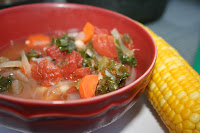
It is essential that we not only provide our families with healthy, delicious meals but clean ones as well. Unless you are an Agrarian, you really don’t know where your food has been or how clean it is. If you are like most people, you buy your food at a supermarket. If you buy from a supermarket your food has likely been touched by several sets of hands—hands that may or may not have been washed…
A little note about buying organic produce: If you don’t/can’t/won’t buy organic, your food could contain potentially harmful pesticides and herbicides. If you are interested, here is EWG’s Dirty Dozen (baker’s dozen really) list of foods you should consider buying organic along with their Clean-15 list of foods that should be safe to eat that aren’t organic: Clean-15 and Dirty Dozen
A few things you may need before you get started:
- Strainers of different sizes
- One mesh—great for grains and lentil
- One large strainer—I prefer metal
- Two cutting boards (if you cook and prepare meet at your house)
- One for raw meat and one for everything else
- Ingredients for one (or both) of the two fruit/veggie soak/rinse recipes
- Spray recipe ingredients—Spray bottle, Lemon and Baking Soda
- Soak recipe ingredients—Vinegar and Salt (my preference)
I hope I haven’t over promised when I said, “absolutely everything”… If I did forget something, I will update this list later.
How to Wash Grains—Rice, Quinoa, Barley, Farro, Etc.:
1. Fill bowl with cold water
2. Add rice and use fingers to mix, rubbing grains gently between palms
3. Discard dirty water
4. Repeat until water is clear
NOTE: Mesh strainer comes in handy here but it is not essential. Also, this step could take several (10+) before the water is clear. Enriched rice may never truly produce “clear” water. Rinsing grains, specifically rice removes excess dirt and surface starch.
How to Wash Dry Beans, Legumes and Lentils:
1. Sort beans
a. Spread beans on a table
b. Examine each bean careful for:
i. Discoloration
ii. Abnormalities (small shriveled, excessively dirty or anything that doesn’t look normal/appetizing)
iii. Rocks or clumps of dirt
iv. Discard any misfits above
2. Fill bowl with cold water
3. Add beans and use fingers to mix, rubbing gently between your palms
4. Discard dirty water
5. Repeat until water is clear
NOTE: Mesh strainer comes in handy for small beans or lentils. If you are using a slow cooker (crock pot) the sorting process is made easier using the glass lid.
How to Wash Fruits and Vegetables:
1. Clean the inside of your sink and fill with warm water (cool if green leafy vegetables, sprouts, grapes or berries)
2. Add ¼ cup Vinegar
3. Add 2 Tbsp Salt
4. Let Fruits/Vegetables soak for 30 minutes
5. Use scrubber to remove excess dirt
6. Drain and Rinse under cool tap water
NOTE: I usually wash everything as soon as I come home from the store, so I don’t have to worry about it later. Also, did you know those little stickers on fruit are made of edible paper? Although they probably don’t taste great, it shouldn’t harm you to eat it. If you are interested in using the spray cleaner, please use the recipe below.
Fruit/Vegetable Spray Cleaner
· 1 Tbsp Fresh Lemon Juice
· 1 Tbsp Baking Soda
· 1 Cup Water
Directions: Combine all ingredients into a spray bottle and gently shake. Beware—this mixture has a tendency to foam up so don’t shake too hard. Spray fruit/vegetables and let sit for 2-5 minutes. Rinse under cold water.
How to Wash Meat:
1. Note from the USDA - Washing raw poultry, beef, pork, lamb, or veal before cooking it is not recommended. Bacteria in raw meat and poultry juices can be spread to other foods, utensils, and surfaces. We call this cross-contamination.
Some consumers think they are removing bacteria and making their meat or poultry safe. However, some of the bacteria are so tightly attached that you could not remove them no matter how many times you washed. But there are other types of bacteria that can be easily washed off and splashed on the surfaces of your kitchen. Failure to clean these contaminated areas can lead to food borne illness. Cooking (baking, broiling, boiling, and grilling) to the right temperature kills the bacteria, so washing food is not necessary.
Using a food thermometer is the only sure way of knowing if your food has reached a high enough temperature to destroy food borne bacteria. Cook all raw beef and veal steaks, roasts, and chops to a minimum internal temperature of 145 °F as measured with a food thermometer before removing meat from the heat source. For safety and quality, allow meat to rest for at least three minutes before carving or consuming. For reasons of personal preference, consumers may choose to cook meat to higher temperatures.







